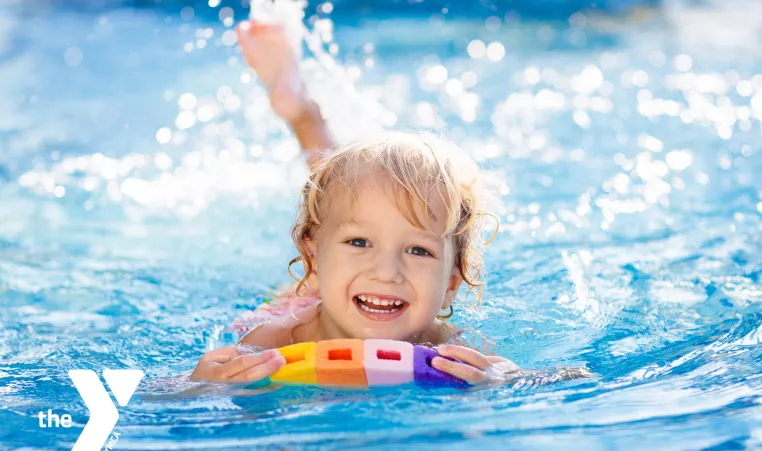
Water Safety at the Y!
With summer coming, school taking a recess, families taking trips together, a lot of water fun is in the view ahead. How can you help prepare your little one to be safe around the water? We have all heard the statistic that the world is 71% water, children are 100% curious, 2 kids die everyday from drowning, drowning is the second cause of death for children ages 5-14, children under 5 87% of drownings occur in home pools or hot tubs, 60% of children who drown are within 10 feet of safety…but it doesn’t need to be that way.
At the YMCA, we offer a great swim lesson program which focuses on safety around water by teaching children: to always ask permission before getting into the water, swim float swim, and jump push turn grab. Swim lessons give children an onsite experience at a pool, with an instructor teaching skills to save lives. Asking permission lets a parent or a caregiver know that the child’s curiosity is there to go swimming. Even thou a parent or caregiver may say “no”, that child may still have that determination that they are going to go swimming. Let’s take four-year-old Rylan for example, a cool summer day, visiting grandma and grandpa who have a backyard pool. Rylan went to mom and said, “I want to go swimming”. Mom was quick to reply, “no, not now”. Two more times Rylan asks mom to go swimming, both times mom replies with “no”. Moments later, the sound of little cowboy boots stomping on the deck followed by a splash. Determined to swim, Rylan jumps into the pool, fully clothed. Because of his swim lessons all winter, Rylan was able to swim back to the side laughing the whole way back saying, “I told you I wanted to swim.”
The YMCA’s current swim lesson program was built around the YMCA Safe Around Water program which offers both land and pool activities to help teach children in all different surroundings how to be safe around the water. One way that this program is used, is by working with local area schools and reaching out to current second grade students. Second grade students are the chosen age group, because this group of students are getting to the age to understand the bigger picture of water safety and its importance along with becoming the age where children are able to frequent local area swimming pools without an adult present.
This spring, around 170 second graders at Northeast Elementary in Glenwood, IA, all participated in a PE class full of water safety. This second graders reviewed common pool rules at most locations: no running, no pushing, no diving in shallow water, wear your sunscreen, stay out of deep water if you’re not a strong swimmer; and of course, always ask permission before getting into the water. After reviewing pool rules, the students were divided into teams and learned about when to wear a life jacket and how to properly put it on and take it off. The second graders then practiced with their team, a life jacket relay where each child would: put on the life jacket, “swim” (run with swimming motion arms) to the other side and back, take off the life jacket, and pass it to the next child in line. After the life jacket relay, the second graders then spread out around the gym floor to practice the swimming lesson benchmark skill of jump, push, turn, grab. This skill is taught to teach children when they jump into the water, how to push off the bottom, turn around and grab the wall to get out safely. Next, the second graders were asked what they would do if they were swimming with their friends and someone got into water that was too deep to get back to safety. The ultimate answer: Reach or throw, don’t go. To practice this skill, the second graders were divided into pairs and each group had a scooter and a pool noodle. The purpose of the activity is to have one student represent a child in the pool struggling to get to the wall (belly down on the scooter), and the second student, practicing good form to help them to safety (laying down on their belly, extending the pool noodle and pulling hand over hand to bring their partner back to the wall). After completing the exercise, they students all came back together for a recap.
As we are gearing up this month for National Water Safety month, here are some fun ideas you can try at home to practice water safety skills:
►Hole in the Bucket:
Equipment Needed:
- Large container filled with water.
- Smaller buckets or large plastic bowl for receiving water.
- Foam cups with holes in the bottom.
To Play: Set the smaller buckets or large plastic bowls on the opposite side of your playing area from the large container filled with water. The racers use their foam cups with the holes in the bottom to scoop up water from the large container and walk (no running since running is against pool rules) it to the opposite side and dump the remaining water into their smaller bucket or large plastic bowl. The first racer to fill their bucket wins.
The Takeaway: Running is against pool rules and can be dangerous. It may lead to slipping, falling, and getting hurt..
►Jump Rope Water Splash
Equipment Needed:
- 1-2 jump ropes
- Plastic or paper cups (one per person)
- Jug or pitcher of water
To Play:Two group members at a time take turns twirling a large jump rope. One by one, each group member attempts three consecutive jumps over the twirling rope while holding his or her cup of water and trying not to let any water spill. The group member with the most water left in his or her cup after three jumps wins, or the group keeps playing until only one person has water left.
The Takeaway: Water makes pool decks slippery and dangerous. Don’t run, jump, push, or play roughly at the pool. It may lead to slipping, falling, and getting hurt.
►Sponge Toss
Equipment Needed:
- 2 containers filled with water
- 2 receiving buckets
- 2 large sponges
SETUP: Divide the group into two teams. Have the teams stand in a line, with teammates facing each other about arm’s length apart. At the head of each team’s line, place a large container of water with a sponge in it. At the other end, place a receiving bucket.
TO PLAY: The first team member in line throws a wet sponge to the teammate across from him or her, who throws it to the next teammate across, and so on. The last team member in line squeezes the sponge into the receiving bucket, walks it back to the head of the line (no running allowed!), and takes over the head position, moving everyone else back one position. Repeat until the receiving bucket is filled. If a sponge is dropped, it is thrown back to the start. The first team to fill its bucket wins.
THE TAKEAWAY: Running is against pool rules and can be dangerous. It may lead to slipping, falling, and getting hurt.
